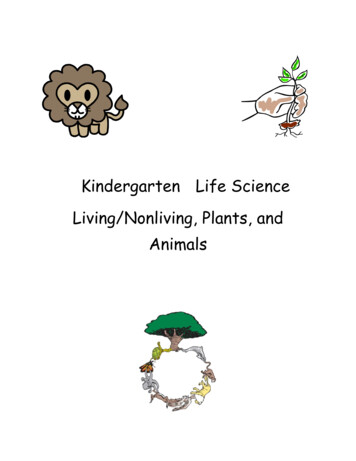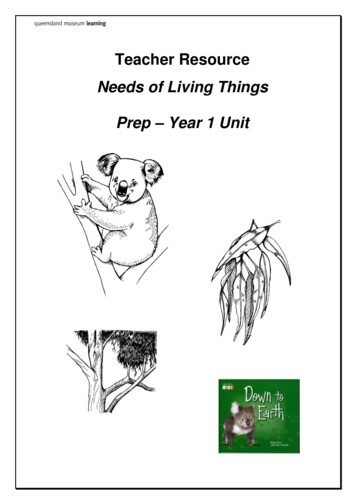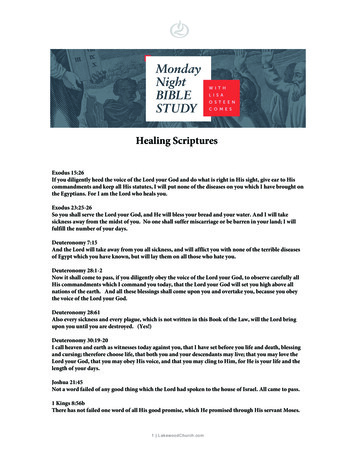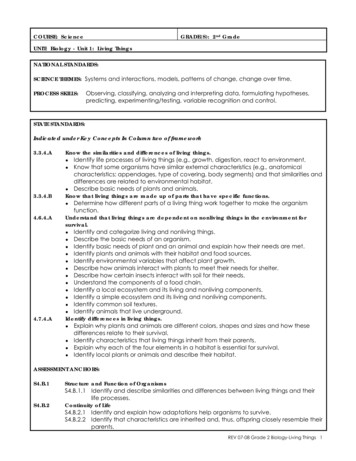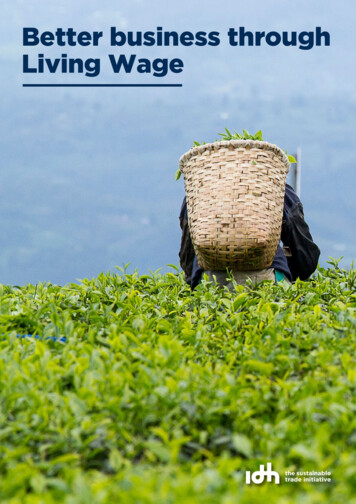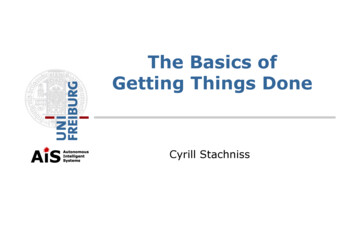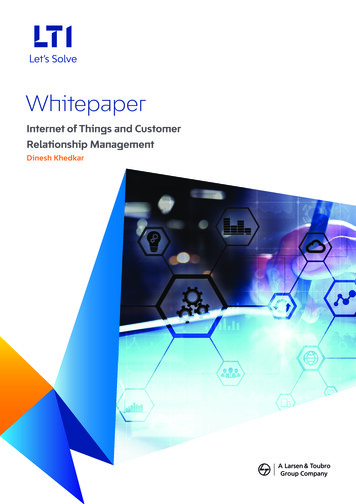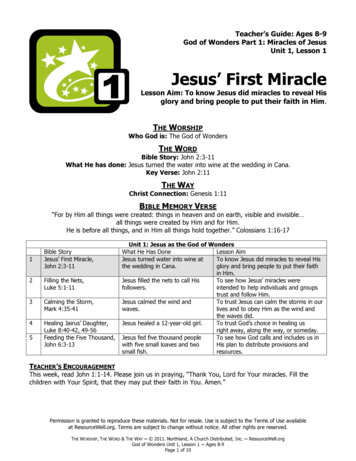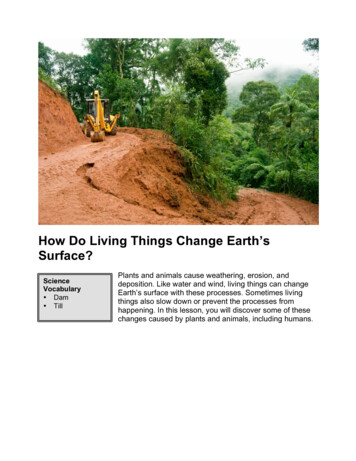
Transcription
How Do Living Things Change Earth’sSurface?ScienceVocabulary Dam TillPlants and animals cause weathering, erosion, anddeposition. Like water and wind, living things can changeEarth’s surface with these processes. Sometimes livingthings also slow down or prevent the processes fromhappening. In this lesson, you will discover some of thesechanges caused by plants and animals, including humans.
1. Plants Cause Erosion and WeatheringThe roots of a tree can grow into cracks in rocks, forcing them apart. The weathered pieces canthen be eroded more easily by water and wind.One reason why Earth is special is that it is covered in plant life. Plants can be big,like a tree, or so small you need a microscope to see them. Each plant helpschange Earth’s surface.Plants change Earth’s surface through weathering and erosion. Suppose you arehiking in a rocky area without many plants. It is hard for plants to grow where thereisn’t any soil. Small plants like moss grow on the rock first. They take minerals fromthe rock. This is a type of weathering, and it weakens the rock. Eventually thesurface of the rock starts to break down and become soil.It is hard to observe soil forming because it takes a long time, but other changesare easier to see. As larger plants like trees start to grow in a rocky area, their rootsgrow into the small cracks in the rock. Slowly, as the tree grows, its roots break therock apart. This forms more soil and makes it easier for other plants to grow thereas well.Plants affect erosion too. You learned that plants help make soil, and often this soilremains in place. Eventually though, some of this soil erodes away. The rock thatplants have weathered can then be more easily eroded.
2. Plants Prevent Erosion and WeatheringBeach grass catches grains of sandthat are moving in the wind. It causes alot of deposition in sandy areas wherethe grass lives. This builds up andslows down sand dunes.You just learned that plants cancause weathering that leads toerosion. But plants can alsoprevent or slow down weatheringand especially erosion.Plants’ roots affect weatheringand erosion. Again, picture theroots of the trees in a rocky area.Although these roots can crackrock, they can also slow downand trap pieces of rock and soil.The roots hold on to this material.They keep water and wind fromcarrying it away. The soil then helps prevent the rock underneath it from quicklyweathering away.Sometimes roots also cause deposition. Water that is carrying sediment can beslowed down by roots. Some of the sediment in the water gets deposited and buildsup. The roots continue to grow and catch more sediment. Eventually the depositedmaterial becomes packed. This makes it harder to erode, and the soil is nowdeeper than before.Plants in dry, sandy areas slow down weathering and erosion, and they causedeposition. The leaves of small plants catch and deposit sand that is being blownover the ground by the wind. Thisslows down the process of winderosion. The sand continues tobuild up, catching and depositingmore sand. Over time, small hills ofsand can form. Eventually, shiftingdunes can turn into grasslands.Tree roots can trap rock and soil. Thishelps prevent erosion in the area aroundthem.
3. Animals Cause Erosion and WeatheringWhen a prairie dog burrows, it scrapesaway the top layer of soil and pushesdeeper soil to the surface. This loosensthe soil. Wind and water can now erode itmore easily.Plants are not the only living thingsthat can cause weathering anderosion. Animals, including humans,change Earth’s surface with theseprocesses too.Animals can cause weathering. Forexample, you might see snails along rocky ocean shorelines. Some of these snailseat algae that grow just under the surface of the rock. They use their hardmouthparts to scrape away the surface of the rock to eat the algae. This constantscraping of many thousands of snails weathers and erodes the rock over time.Animals that burrow, or dig holes for shelter, change Earth’s surface. On theAmerican prairie, you might see many mounds with holes in them. These are thehomes of prairie dogs, a type of burrowing animal. The holes protect the prairiedogs from weather and predators. To make a burrow, a prairie dog scrapes awaythe top layer of soil. This breaks up the hard surface. The prairie dog continues todig deep into the ground and push soil up to the surface. This movement of soil iserosion. The soil is now loosened and more exposed. Wind and water might carry itaway.Animals cause erosion in other ways too. When too many animals live in one place,they tend to eat and trample all the plants. Without the plants to protect the soil, it ismuch more likely to be eroded by wind and water.Animals cause weathering and erosionon rocky shorelines. Snails and otheranimals scrape rock as they feed onalgae, repeatedly removing the top layer.
4. Animals Cause DepositionAbeaver dam causes a flowing river to slow down. The river then deposits much of its soil and mudin the beaver pond behind the dam.Animals like sea snails and prairie dogs change Earth’s surface with weatheringand erosion. Can animals change Earth’s surface with deposition?A beaver is one animal that changes Earth’s surface by depositing material.Beavers build dams. A dam is a wall of material that blocks the flow of a stream orriver. Beavers use dams to get food and to protect themselves. The dams alsoallow them to access their homes. Beavers build their dams on a stream or riverusing rocks, mud, and pieces of trees. The dam stops water from flowing. Waterbuilds up behind the dam, which causes a pond to form. Some of these ponds arelarger than a football field!The water flowing into the pond deposits sediment. Upstream of the dam, the rivererodes rock and soil as it flows. It carries sediment along in the current. But once adam is in place, the water no longer can flow easily. When it reaches the dam, theriver slows down. The sediment that it is carrying slows down too. Much of the rockand soil is deposited at the bottom of the pond.The sediment builds up over many years. It is now deposited on the bottom of thebeaver pond, instead of flowing in the water. So, the water flowing out of the damhas less sediment and is clearer than it was. A large dam that exists for many yearscan cause a lot of deposition.
5. Humans Cause ErosionPaths are formed by walking in the same areamany times, which erodes material. In the rightplaces though, paths help prevent erosion.Like other animals, humans change Earth’ssurface. As you know, many naturalprocesses cause erosion. But humans oftenmake this process happen much faster thanis natural.Humans sometimes cause erosion withouttrying. Suppose you and your friends walkthrough a field to get to school. Where youwalk, some of the grass is worn down. If theground is wet you might leave footprints.When people walk over the same areaoften, they can wear a path where plants nolonger grow. Since the soil is exposed, itmight be eroded by water or wind. Paths arenot always bad because they keep all of thedamage in one place. But if they are in the wrong place, like somewhere steep, itcan be a problem.Construction projects can cause a lot of erosion. When people clear land to makeroom for new buildings, they scrape away the plants that used to live in the area.While they are building, a lot of the soil is left uncovered. This lets water and winderode the soil.Sometimes, humans speed up soil erosion by having pets or raising animals.Usually, plants eaten by wild animals grow back quickly. But if there are too manyanimals in an area, they can eat the plants faster than they grow back. Thisuncovers soil and rock so that it erodes faster.Construction is a human activity that causeserosion. By scraping away the plants that usedto live here, the soil is no longer protected fromwater and wind.
6. Humans Can Reduce ErosionSinceerosion cancausedamage,humansdesignsolutions toprevent it.Sometimespeople buildterraces,like thisone. Bymakingmanysections offlat land,terraceshelppreventerosion.Like other organisms, humans can also prevent weathering and erosion. Sinceerosion can cause damage, humans take measures to prevent this from happening.You have learned how soil forms and collects. This takes a long time. Soil erosioncan happen much faster than the soil forms and valuable soil can be lost. The soilthat is eroded can damage buildings or pollute the water.One cause of soil erosion is planting crops on steep slopes or in dry areas. Beforethey plant their crops, farmers till the soil. To till the ground is to break it up or turnit over to prepare the soil for planting crops. Before the crop plants come up or afterthey die, erosion increases.One way to prevent soil erosion is by only planting crops in the right places. Winderosion is a risk where it is very dry. Water erosion is a problem in steep, wet areas.People usually should not till the land in very steep and dry places.In some parts of the world, people make terraces on hillsides. Each terrace is flatlike the step of a staircase. Rainwater stays on each terrace for a long time so theplants can use the water for growing. This prevents soil erosion and lets peoplefarm where the land is steep.You can see how living things, including humans, change Earth’s surface. Livingthings weather, erode and deposit material. They move this material to new places.
Summary: How Do Living Things Change Earth’s Surface?1. Plants Cause Weathering and Erosion Plantsweather and erode Earth’s surface. Plant roots inparticular can weather rock down in many ways.Plants like moss take minerals from rocks and breakthe rocks down. By weathering rock, plants help formnew soil.2. Plants Prevent Erosion and WeatheringPlant roots can also prevent erosion by holding ontosoil and rocks. They slow down the rate of erosion,and sometimes even cause deposition. Plants helpkeep the soil in place.3.Animals Cause Erosion and WeatheringSome animals weather rocks by scraping them asthey feed. Other animals change Earth’s surface byburrowing into it and moving material. Too manyanimals in one place can destroy most of the plants,leading to faster erosion.
4.Animals Cause Deposition Some animals,like beavers, cause deposition. Beavers build damsacross streams and rivers. When the water behindthe dam slows down, it deposits the sediment itwas carrying.5. Humans Cause Erosion Humans havegreatly increased the amount of erosion on Earth.This is often caused by humans removing the wildplants that protect the soil. Activities likeconstruction projects and farming can all increaseerosion.6. Humans Can Reduce Erosion People shouldfarm and build in ways that do not cause too mucherosion. Crops should normally not be planted insteep or dry areas. People have designed solutionslike terraces to let them farm in these areasresponsibly.
Reading FurtherSaving SoilHumans change Earth’s surface more than any other species. The history of theGreat Plains of North America serves as just one example of how people havereshaped the planet.People first came to the Great Plains about 12,000 years ago. For food, they mostlyhunted animals and gathered wild plants. Then they started farming in small areasnear rivers, avoiding the grassy soils that covered most of the Plains. In the mid1800s, European settlers began to move from the east to the west. As they did,they completely changed the surface of the Great Plains. The change began whenthey dug into the grass.The climate of the Great Plainsincludes cold winters, hot summers,a lot of wind, and little rain. Theplants native to the region are mostlytall grasses. The deep roots andlower stems of the grasses keeploose earth in place. This forms aspecial layer in the ground calledsod. Sod traps any rain that falls.This process allows very deep, richsoil to develop through the years.Settlers from the East realized thatthe rich soils of the Great Plainswould be perfect for farming. Theywanted to use it to grow crops, sothey cleared fields by digging up sod.In some places the sod was so thickthat the settlers used chunks of it tobuild homes. But removing this sodwould eventually lead to devastatingchanges in the landscape.People built this home from blocks of sod inthe prairie.
Soil Is Formed and LostGrasslands have covered the Great Plains for thousands of years. As some soileroded, more soil would form. Insects, grasses, and tiny living things made new soilfrom rock and dirt. Grasses held the rich, loose soil in place. Animals such as bisonate the grasses without disturbing the soil much. And enough rain fell to maintainthis soil and the living things it supports. Life, soil, and erosion were each balancedwith one another.Most trees and shrubs on the Plains naturally grew only near creeks and rivers.These wet areas were often far apart. At one time, people could look for longdistances in any direction and see only grass. This is why many describe the Plainsas a sea of grass. But the Plains also get little rain. So, even with all that grass,people also call it the Great American Desert. In such a dry place, even smallchanges can upset the balance between life, soil, and erosion.Settlers began to farm on the Plains by clearing the grasses with plows. A plow ismade of blades that are like huge knives for cutting into the ground. Farmers useplows to till the soil before planting seeds. Plows also bury weeds and dead cropplants. With tilling, soil is left without plant cover for a many months. In a windyplace like the Plains, tilling tips the balance from soil formation toward soil erosion.In tilling,plows areused toclear thegroundbefore andaftergrowingcrops.
A Big Bowl of DustAt first, people farmed in the Great Plains without many problems. But severalchanges caused farmers to till more of the soil. Starting in the late 1800s, inventorsmade many new machines. New plows let farmers till more land easily and quickly.Then during the 1910s and 1920s, it rained more than normal. The extra rain letfarmers grow more plants. A demand for wheat caused wheat prices to be high.The government pushed people to replace great amounts of grassland with wheatfarms. People around the country began to depend on the wheat. Meanwhile, alarge amount of the Great Plains lost its natural grass cover.During the early 1930s, almost no rain fell for several years. This is called adrought. Crops could not grow, so people left the farms. The powerful springwindstorms of the Great Plains came as usual. Only this time, soil that had taken somany years to form was easily carried away. Scientists estimate that 850 milliontons of soil was lost. This era of severe dust storms throughout the Great Plains iscalled the Dust Bowl.Periods of soil erosion have happened many times in history. Droughts still happenas part of natural changes in climate. The Dust Bowl is one example of how humanchanges to land can act with natural changes to create disasters.A dust stormapproachesbuildings inStratford,Texas, in1935.
One Possible SolutionThe good news is that people have learned a lot from events like the Dust Bowl.Scientists who study soil problems all over the world look for solutions. Wherefarming methods cause problems, people try other ways to grow food. One methodis no-till farming. As the name suggests, no-till farming does not rely on usual tillingmethods. Its goal is to disturb the soil as little as possible.In normal tilling, farmers plow a field many times each season. In no-till farming,plows disturb the soil only when it is time to plant seeds. This has severaladvantages. One is that soil gets packed down less because machines drive overthe field less. Loose soil is good for crops because air, water, and nutrients canmove more easily to the plants. Using less equipment also means using less fuel.Tilling removes weeds and stubble from fields. Stubble is the remains of old cropplants. No-till farming leaves stubble on the fields. Stubble helps to trap snow inwinter, which means more water for the soil later. Stubble and snow also act like ablanket over the soil. They keep it warmer through winter and hold the soil in placethe rest of the year. Stubble also protects new seeds in the spring.With no-till farming, soil erosion occurs at about the same speed as soil formation.And this may be the key to bringing life, soil, and erosion back into balance inplaces like the Great Plains.A blanket ofsnow getstrapped in theremains of oldcrop plants. Thiskeeps the soilwarmer throughwinter andmeans morewater for the soilthe rest of theyear.
The water flowing into the pond deposits sediment. Upstream of the dam, the river erodes rock and soil as it flows. It carries sediment along in the current. But once a dam is in place, the water no longer can flow easily. When it reaches the dam, the river slows down. The sediment that it is carrying slows down too. Much of the rock

